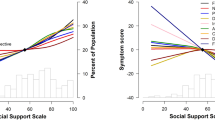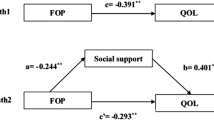Abstract
Purpose
The purpose of this study was to investigate: (1) how social support influences quality of life (QOL) and (2) whether or not the pathways for predicting QOL outcomes differ between Korean American and Korean survivors of breast and gynecological cancer.
Method
To identify multiple dimensions of health status and psychosocial outcomes, two standardized QOL and psychological distress measures were administered to 51 Korean Americans and 110 Koreans. Social support was measured by items assessing functional social support and social network structures. Hierarchical multiple regression and path analyses were employed to investigate the effects of social support on outcomes and to compare between Korean Americans and Koreans.
Results
The findings indicate that functional social support directly influences QOL and psychological distress, and social network structures are directly and/or indirectly associated with outcomes. Moreover, the two groups showed different pathways from social support to outcomes.
Conclusion
This study provides practical research information by illuminating the relationships between social support components influencing QOL for Korean American and Korean survivors. This study may increase the utility and efficacy of the research and interventions to enhance cancer survivors’ social participation and to diminish barriers to follow-up care, considering the different living conditions between the United States and Korea.

Similar content being viewed by others
Notes
“Involvement” refers to an actor’s relative depth of involvement in social relations.
Demographic and medical variables, which showed significant group differences, were considered as confounders.
This model is similar to Fig. 1, but substitutes a “side effect” for the “years since diagnosis,” and the correlation between “years since diagnosis” and “financial impact” has been removed.
References
ACS, Cancer facts and figure (2004). Atlanta, GA: American Cancer Society.
Korea Central Cancer Registry (2002). Annual Report of the Korea Central Cancer Registry. 2003, Ministry of Health and Welfare, Republic of Korea.
Dorsett, D. S. (1991). The trajectory of cancer recovery. Scholarly Inquiry for Nursing Practice, 5, 175–184.
Pedro, L. W. (2001). Quality of life for long-term survivors of cancer: Influencing variables. Cancer Nursing, 24, 1–11.
Ma, G. X. (1999). The culture of health: Asian-American Communities in the U.S. Greenwood, Wesport, CT.
Kim, M. T., et al. (2001). Cardiovascular disease risk factors in Korean American elderly. Western Journal of Nursing Research, 23(3), 269–282.
Kim, M. T. (2002). Measuring depression in Korean Americans: Development of the Kim depression scale for Korean Americans. Journal of Transcultural Nursing, 13(2), 109–117.
Ryu, H., Young, W. B., Park, C. (2001). Korean American health insurance and health services utilization. Research in Nursing & Health, 24(6), 494–505.
Ashing-Giwa, K. T., et al. (2004). Understanding the breast cancer experience of women: A qualitative study of African American, Asian American, Latina and Caucasian cancer survivors. Psycho-Oncology, 13(6), 408–428.
Ashing-Giwa, K. T., et al. (2007). Examining predictive models of HRQOL in a population-based, multiethnic sample of women with breast carcinoma. Quality of Life Research, 16(3), 413–428.
Anderson, G. F. (1989). Universal health care coverage in Korea. Health Affairs, 8, 24–34.
Lee, E. E. (2004). Depression among Korean, Korean American, and Caucasian American family caregivers. Journal of Transcultural Nursing, 15(1), 18–25.
Blanchard, C. G., et al. (1995). The role of social support in adaptation to cancer and to survival. Journal of Psychosocial Oncology, 13, 75–95.
Lehto-Jarnstedt, U. (2004). Cancer-specific social support received by newly diagnosed cancer patients: Validating the new structural-functional social support scale (SFSS) measurement tool. Supportive Care in Cancer, 12, 326–337.
McClement, S. E., Woodgate, R. L., & Degner, L. (1997). Symptom distress in adult patients with cancer. Cancer Nursing, 20, 236–243.
Ashing-Giwa, K. T., et al. (2004). The impact of cervical cancer and dysplasia: A qualitative, multiethnic study. Psycho-Oncology, 13, 709–728.
Berkman, L. F., et al. (2000). From social integration to health: Durkheim in the new millennium. Social Science & Medicine, 51, 843–857.
Lim, J. W., & Zebrack, B. (2006). Social networks and quality of life for long-term survivors of leukemia and lymphoma. Support Care Cancer, 14, 185–192.
Michael, Y., et al. (2002). Social networks and health-related quality of life in breast cancer survivors: A prospective study. Journal of Psychosomatic Research, 52(5), 285–293.
Ganz, P. A., et al. (2002). Quality of life in long-term, disease-free survivors of breast cancer: A follow-up study. Journal of National Cancer Institute, 94(1), 39–49.
Lewis, J. A., et al. (2001). Social support, intrusive thoughts, and quality of life in breast cancer survivors. Journal of Behavioral Medicine, 24(3), 231–245.
Veenstra, G. (2000). Social capital, SES and health: An individual-level analysis. Soc Sci Med, 50(5), 619–629.
Sammarco, A. (2001). Perceived social support, uncertainty, and quality of life of younger breast cancer survivors. Cancer Nursing, 24(3), 212–219.
Northouse, L. (1988). Social support in patients’ and husbands’ adjustment to breast cancer. Nursing Reseaqrch, 37(2), 91–95.
Samarel, N., et al. (1998) Women’s perceptions of group support and adaptation to breast cancer. Journal of Advanced Nursing, 28(6), 1259–1268.
Michael, Y. L., Berkman, L. F., Colditz, G. A., Holmes, M. D., & Kawachi, I. (2002). Social networks and health related quality of life in breast cancer survivors: A prospective study. Journal of Psychosomatic Research, 52, 285–293.
Ferrell, B. R., Hassey, D. K., & Grant, M. (1995). Measurement of the quality of life in cancer survivors. Quality of Life Research, 4, 523–531.
Zebrack, B., & Cella, D. (2004). Evaluating quality of life in cancer survivors.
Ell, K. (1984). Social networks, social support, and health status: A review. Social Science & Medicine, 58, 139–149.
Gambosi, J. R. (1990). Recovering from cancer: A nursing intervention program recognizing survivorship. Oncology Nursing Forum, 17, 215–219.
Leigh, S. (1999). Survivorship: What does it mean to nurse? Innovations in Breast Cancer Care, 4, 37–38.
Pollack, L. A., et al. (2005). Cancer survivorship: A new challenge in comprehensive cancer control. Cancer Causes and Control, 16(Suppl. 1), 51–59.
National Coalition for Cancer Survivorship (NCCS), NCCS Charter. (1986), Silver Spring: MD: National Coalition for Cancer Survivorship.
Derogatis, L. R. (2000). Brief Symptoms Inventory (BSI) 18 administration, scoring, and procedures manuel. Minneapolis, MS: National Computer Systems Inc.
Sherbourne, C. D., & Stewart, A. L. (1991). The MOS social support survey. Social Science & Medicine, 32(6), 705–714.
Cohen, S., et al. (1997). Social ties and susceptibility to the common cold. JAMA, 277, 1940–1944.
Norusis, M. (2006). SPSS 15.0 User’s guide. Chicago, SPSS Inc.
Arbuckle, J. L. (2006). Amos user’s guide version 7.0, ed. S. Corporation. Chicago.
Arbuckle, J. L. (1997). Amos user’s guide version 3.6, ed. S. corporation. Chicago.
Kline, R. B. (1998). Principles and practice of structural equation modeling. New York: Guilford Press.
Zebrack, B. (2000). Quality of life long-term survivors of Leukemia and Lymphoma. Journal of Psychosocial Oncology, 18(4), 39–59.
Kuo, W. H. (1984). Prevalence of depression among Asian-Americans. Journal of Nervous and Mental Disease, 172, 449–457.
Kiefer, C. W., et al. (1985). Adjustment problems of Korean American elderly. Gerontologist, 25, 477–482.
Oh, Y., Koeske, G. F., & Sales, E. (2002). Acculturation, stress, and depressive symptoms among Korean immigrants in the United States. The Journal of Social Psychology, 142(4), 511–526.
Chun, M., Knight, B. G., & Youn, G. (2007). Differences in stress and coping models of emotional distress among Korean, Korean American and White-American caregivers. Aging & Mental Health, 11(1), 20–29.
Lim, J., & Zebrack, B. (2006). Social networks and quality of life for long-term survivors of leukemia and lymphoma. Supportive Care in Cancer, 14, 185–192.
Sapp, A. L., et al. (2003). Social networks and quality of life among female long-term colorectal cancer survivors. Cancer, 98(8), 1749–1758.
Chesler, M. A., Weigers, M., Zebrack, B., & Trever, K. (1996) A brief review of the psychosocial literature and our research plans/progress with adolescent/young adult survivors of chidhood cancer. In The Working Paper Series, #531. Center for Research on Social Organization: University of Michigan.
Zebrack, B. J., & Chesler, M. A. (2000). Managed care: The new context for social work in health care—implications for survivors of childhood cancer and their families. Behavioral Social Work in Health Care Settings, 31(2), 89–103.
Guidry, J. J., Adav, L. A., Zhang, D., & Winn, R. J. (1997). Transportation as a barrier to cancer treatment. Cancer Practice, 5(6), 461–466.
Janevic, T. Korean american community health survey: Alameda and sata clara counties, ca. 1997, University of California, Berkeley School of Public Health, Korean Community Advisory Board, and Asian Health Services.
Author information
Authors and Affiliations
Corresponding author
Rights and permissions
About this article
Cite this article
Lim, Jw., Zebrack, B. Different pathways in social support and quality of life between Korean American and Korean breast and gynecological cancer survivors. Qual Life Res 17, 679–689 (2008). https://doi.org/10.1007/s11136-008-9343-4
Received:
Accepted:
Published:
Issue Date:
DOI: https://doi.org/10.1007/s11136-008-9343-4




